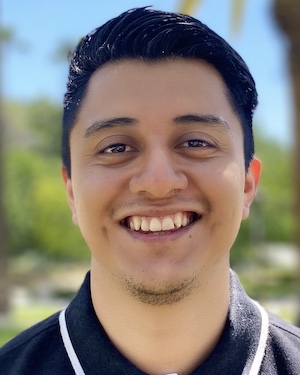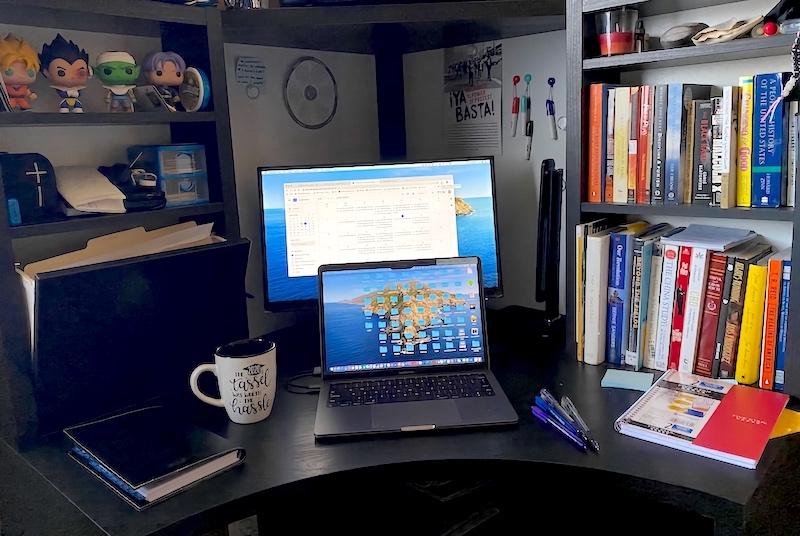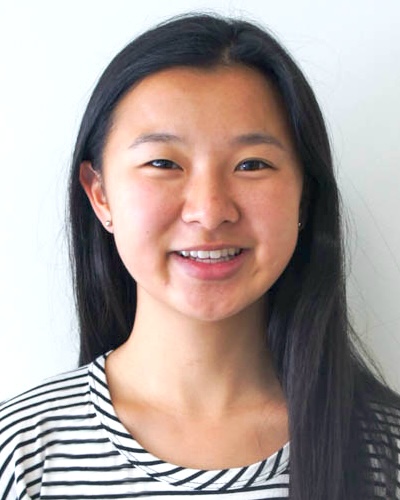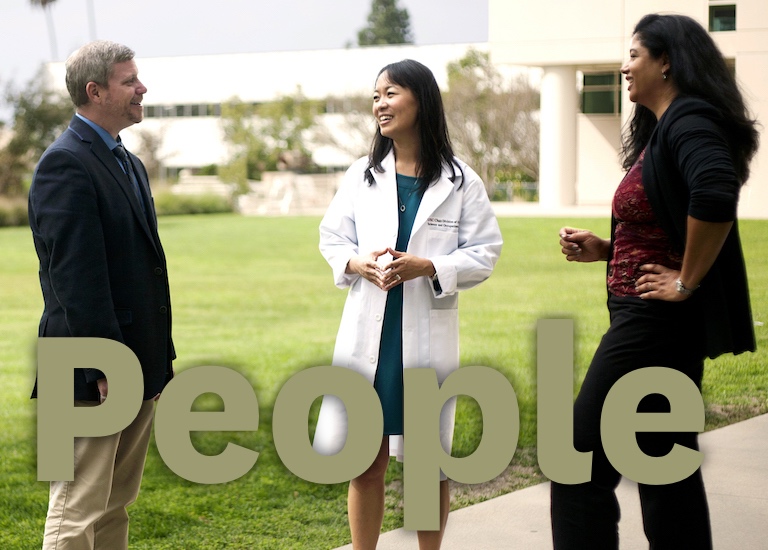Student Blog

A Busy Day in Primary Care Fieldwork — from Home! ⟩
June 11, 2020, by Daniel
This summer I am doing my level 2 fieldwork with my OTD residency site under the Lifestyle Redesign for Chronic Conditions Lab (LRCC) in primary care at the LAC+USC Adult West Clinic. This OTD residency is designed to expand occupational therapy (OT) services in primary care, focused on addressing chronic condition management among patients with diabetes and/or hypertension, using a Lifestyle Redesign® approach. This summer I am being trained by the current OTD Resident in preparation to take over the full caseload this Fall.
Currently, the primary care clinic does not have a video platform and we are not allowed to use Zoom to interact with patients, thus all of the appointments are three-way phone visits using Doximity (HIPAA compliant) with supervision from my clinical instructor (CI) through the phone and Zoom. I am able to lead appointments in English and Spanish, which is valuable for our predominantly Spanish speaking community at the clinic. The phone visits can be beneficial for some patients as they don’t have to travel far to get to their appointments and can talk to their providers from the comfort of their home. However, there are also barriers for our patients such as not having a quiet space at home or disconnected phone lines due to being unable to pay their phone bill as a result of the pandemic. We do our best to contact all our patients and provide as much support as possible to help them navigate these barriers and be able to manage their health.
Each day can look very different when doing telehealth in primary care, and below I wanted to share an example of a typical busy Wednesday! On this particular day, I started my day with an OTFP in-service learning about mental health when utilizing Lifestyle Redesign® approaches. Next, my CI and I started calling patients since we had done chart reviews the day before. During our phone visits, we discussed topics such as healthy eating, physical activity, stress management, medication adherence, habits and routines, resources, etc., to support their diabetes and/or hypertension diagnosis and overall health management. In the middle of the day we had consecutive meetings to discuss patient progress and how to better support them (care management); fieldwork/residency updates, logistics, and an opportunity to ask for guidance with clinical approaches (fieldwork supervision); and daily clinic updates and projects (daily brief). And perhaps you are wondering . . . when do you eat? Well, there are days when we don’t get an official lunch break, so we do our best to get food in between meetings! Thereafter, we began calling patients again for the rest of the day and documented in between appointments and during our assigned admin/documentation time at the end of the day.
Typical Wednesday
- 8-9AM – Occupational Therapy Faculty Practice (OTFP) In-Service
- 9-11AM — Patient Phone Visits
- 11AM-12PM — Care Management Meeting
- 12-1PM — Fieldwork Supervision Meeting
- 1:05-1:30PM — Clinic Daily Brief
- 1:30-4PM — Patient Phone Visits
- 4-5PM — Admin Time/Documentation

My workspace at home (please don’t judge my ergonomics/set-up, I’m still working on it).
Tips for working from home
- Take stretch breaks: This is one of the most important things you can do for your body. Taking stretch breaks is important to prevent pain, aches, and cramps later on! You can even do stretches while sitting down.
- Snacks & water: Don’t forget to stay hydrated and have snacks in reach to have energy throughout the day!
- Ergonomics: Posture, posture, posture! Please take care of your bodies and follow proper posture and chair tips when working from home. This can easily be overlooked and if you don’t have fancy equipment, there are ways you can get creative! Your body will thank you later.
- Prepare meals: This can save you time on days when you may have a short lunch break or none at all!
I hope this paints a picture of what a busy day of telehealth primary care may look like! My intention is to be transparent with you all and share the good, the bad, and the busy days. I am often exhausted at the end of the day, but I am excited to continue to learn and the patients make it all worth it!
⋯

A Whole New Virtual World ⟩
June 9, 2020, by Bethany
During this time of social distancing, we’ve learned that it can be difficult to stay in touch with people. Especially as college students, moving away from campus and being back home was quite a transition. And my class’ position as seniors only amplified our experience. We were planning on cramming last minute hang outs together into our final weeks, making the most our proximity, but those weeks never came. However, over time, we began to get creative with the ways that we stayed connected. And even as things slowly open up, there are still some creative ways to stay in touch that we will continue to do.
Zoom Game Night
One of the student organizations I was a part of was Intervarsity Trojan Christian Fellowship. We have a tradition of having Senior Office Hours through the last week for the seniors to hang out with everyone in the fellowship. Organizing these virtually was difficult, but we found a lot of fun games that work over video chat! One of my personal favorites (and one at which I am unfortunately not that great) is Codenames. In Codenames, you work with your team to help them make the correct selections on a grid of 25 random words by using only one word clues.
Skribbl.io is an online version of pictionary that has one player draw at a time while the others type in guesses. It is even more fun to add the element of video chat to watch everyone’s reactions to the others’ drawings, sometimes bemoaning their own artistic ability. Be careful, though: Spelling counts on this game! Although the program will let you know when your answer is close, you still have to spell it correctly for the answer to go through. One word given was Colosseum, and although the participant drew a beautiful rendition, her audience unfortunately consisted of USC seniors, who were all too familiar with the Los Angeles Memorial Coliseum, where our football team plays every home game. Watching the numerous attempts and re-attempts at spelling was frustrating, but garnered laughs all the same.
You can find many more games here, on a list compiled by another socially-distancing college student. The list is even organized by type of game, from board games to card games and even escape rooms! The author is ever updating the list, so if you have site recommendations, you can send them her way through the link on the document. You’ll find some old favorites, but I highly recommend trying something new, too! I learned Settlers of Catan through the online version, a challenging but overall fun experience.
Team Challenges
My family has taken this time to keep in touch with extended family members as well. Through Marco Polo, a video messaging app, each group of cousins takes turns challenging the other families to post a video in the group. The first challenge was a family dance challenge, where each family choreographed and performed a 30+ second clip. Then we sent the videos to our grandparents, and they came up with their own categories of choreography, enthusiasm, costuming, and more to rank each performance. I’m proud to say that my family got top marks for enthusiasm when the dog showed up wearing sunglasses for the opening. We’ve also done challenges for mimicking old family photos, recreating a movie scene, and re-writing the lyrics to a song to reflect our social distancing experiences. The challenges are a great way to stay in touch, keep younger cousins busy, and see everyone’s creative side!
Start A Series
Now that we know that many of our gatherings will continue online, what better time to start a series with someone. Netflix Party is one app that allows different users to simultaneously watch the same content. If the content is not through Netflix, there is also a screen-share option through video chat. Anything from TV shows to different movie series, Friends to Harry Potter. Having a series is a nice way to keep continuity and to ensure that you regularly stay in touch with your watch group, because you can’t not watch the next installment!
These are only a few examples of the many ways we’ve learned to keep in touch as the world changes. And even in the future, as things open back up, I look forward to continuing to use these strategies to maintain relationships. Hopefully, you can take advantage of some of these suggestions or come up with some creative ones of your own!
⋯

The Benefits of Remote Learning ⟩
June 8, 2020, by Savi
Pursuing my Entry-Level Professional Master of Arts Degree at USC in the Chan Division of Occupational Science and Occupational Therapy has provided me with a plethora of opportunities to grow as a student and as a future OT. I have been challenged by the curriculum, by my peers, and by my professors to think outside of the box and develop innovative ways to overcome a variety of barriers and challenges. Out of all these challenges, one of the biggest was transitioning our curriculum to remote learning due to the COVID-19 pandemic.
As many who know me would agree, I am not particularly tech-savvy, I am an extremely hands-on learner, and I thrive in social settings. For those reasons, the transition to remote learning seemed somewhat daunting to me. In order to overcome the frustration and fear I had, I decided to develop a list of the benefits of remote learning that I discovered over the last few months. This helped me focus on the positive aspects of remote learning and find the motivation to overcome the hurdles I faced in order to succeed both academically and socially under the circumstances.
For those of you reading this who are about to start their first semester with us at USC in the Chan Division, I know that this is not the same beginning you might have envisioned. For many, that may be frustrating and sad and for some, this may be great news! Whatever you are feeling is valid and I wanted to provide you with the list of the positive aspects I have discovered about taking my courses remotely. I hope that these help you to better enjoy your first semester with us! To those of you already in the program, I hope that this list also helps you if you ever feel like you’re viewing these circumstances in an extremely negative light. On that note . . . here comes my list!
The Benefits of Remote Learning:
- No commute: You can roll right out of bed and into class, plus you can wear your pajamas to school!
- Creativity Boost: As an OT, the number one skill we utilize is creativity. Transitioning to an online format has challenged us to become more creative. Whether that is altering an in-person group therapy session to fit a video conference format, discovering the best way to present a group research paper to our class online, or discovering occupations to utilize during, in between or before class that help us sustain engagement in class, we will all become more well-rounded OTs because of these experiences.
- A better understanding of who your professors are outside of the classroom: I know what you might be thinking . . . how would you get to know someone better through a virtual format than you would in person? Great question! This was the first time I got to see some of my professors and other faculty outside of a true classroom setting. I was able to meet my professors’ family members, animals, and friends and see them in their “comfy clothes” during our one-on-one meetings. These experiences made them even more relatable than before!
- Greater access to office hours: Because I no longer have to travel to school to meet with my professors, I can meet with them ANY TIME! While on campus my professors would make themselves extremely accessible. Now that neither of us has to commute, it has become easier to squeeze in more meetings throughout the day.
- Building relationships with other faculty in the division: Shout out to IT Helpdesk and A/V Technician David Xie, Webmaster Paul Bailey, and the rest of the IT team for helping me overcome the many hurdles I have faced as a student who is not tech-savvy.
- Hearing from more students in your class: Because students can utilize both the chat and the unmute feature, more students can respond to a question posed by the professor during class. Although there is limited time to hear from students during lectures, the chat feature allows for an unlimited amount of responses. This has given me the opportunity to learn from a lot of my classmates’ opinions and experiences.
- Enjoying yoga, meditation, or even a quick nap during a class break! I promise these are very revitalizing occupations, so I urge you to take advantage of them while you can.
⋯

Black Lives Matter ⟩
June 8, 2020, by Calvin
It’s been an extremely unfortunate time right now and I know that so many of us are going through a lot of emotions. Like many of you, I feel disappointed, angry, frustrated, and scared by the current events surrounding the unfair deaths of Black lives. As I’m watching the news on the ensuing nationwide protests for social justice, I’m witnessing the collective trauma being experienced by many, and I am also reflecting on how I can help.
I am proud to be part of the Chan Community, where the USC Chan Division has been committed to addressing these matters by fostering an inclusive educational environment, sharing multiple resources, and holding safe space meetings. It’s reassuring to know that our community is being supported by the division and I’m very much looking forward to attending these meetings.
As an Asian American, I used to believe that this was not my place to speak up and that this was not my fight. I believed that if I felt like I was going to say something wrong, then I shouldn’t say anything at all. In the past, I was silent and scared to have these difficult conversations with my friends and family. I remember times when friends would use derogatory language against certain communities and when my immigrant family members would share their opinions without first attempting to understand. I didn’t say a word to try and correct them. I wasn’t able to resist my complacency.
Throughout my upbringing, I had internalized anti-blackness and my mind was shrouded by the model minority narrative that continues to divide Asian and Black communities. This myth grants exploitative privileges that are weaponized against Black and Latinx communities. I was ignorant to be part of such a detrimental perception that downplays racism in the struggles of other minority groups, especially Black people.
However, as I have grown and reflected on myself and my privilege, I have come to realize that there are many ways to practice allyship in solidarity. By acknowledging the internalized racism embedded within myself and my culture, I have been able to reflect on my actions and challenge my assumptions. I’ve also been trying to promote this dialogue with my family to educate them on the injustices that Black people face. While I am grateful that they are gradually starting to be more open to talking about these topics, I also know that this is just the first step.
Black communities continue to experience barriers to their occupational rights and they continue to have their lives senselessly taken away by authorities who thrive off of this unjust system. It’s very clear that we are still fighting against systemic racism and acts of oppression, and it is so important, and has always been, that we organize and mobilize together in order to educate ourselves and support the Black community.
As future OTs, part of our work is to create a space to listen to the voices of those who are marginalized and oppressed, and to those who don’t have a voice, so that we can help advocate for them. However, we must also challenge people’s assumptions, acknowledge when there is boundary-crossing, and utilize our leadership to foster a supportive and safe environment for our clients and colleagues.
I hope that you can join me in taking this time to reflect and ask ourselves these questions:
- What can I do to continue putting in this effort?
- How can I use anti-racist knowledge to start this dialogue?
- How can I inform myself to continue thinking about these topics?
Here, I share with you all a document that contains links and additional resources to educate yourself, sign petitions, donate, and so many other ways for you to take action. I hope that everyone is staying safe and healthy and that you’re able to take care of yourselves as needed.
Thank you.
⋯

Why Occupational Therapy? ⟩
June 2, 2020, by Savi
From a young age, I have been passionate about a range of interests, including sports, graphic design, leadership, and academic pursuits. When applying to college, I had to focus on which activities would interest me most in a future career. Prioritizing a narrower set of interests was challenging for me since I enjoy exploring new experiences, applying my knowledge in novel ways, and having the opportunity to continuously challenge myself to develop innovative and creative approaches to a problem. These desires, coupled with my personal experiences interacting with occupational therapists in a variety of settings, influenced me to pursue a career in occupational therapy (OT).
After injuring both my thumbs playing as a goalie for my soccer team, I worked with an OT hand therapist during my rehabilitation process. This interaction highlighted to me the importance of creativity in an OT’s approach to designing a treatment plan. My OT worked with me to set goals and develop a treatment plan that best suited my occupational needs. This OT gave me anatomy lessons to help me better understand my injuries and demonstrated ingenuity when developing activities she knew would pique my interest and motivate me. This first hand (or thumb haha) experience taught me that pursuing a career in OT would allow me to continuously challenge myself by developing specialized treatment plans to meet the unique needs of each of my clients, and provide clients with autonomy during their rehabilitation journey.
A few years later, I watched my sister conduct fieldwork immersions while completing her Master’s in Occupational Therapy at USC, and was further convinced that pursuing this profession would allow me to continue to develop innovative approaches to overcome challenging problems in a variety of settings. I witnessed her ability to work with college students to build a foundation of sustainable and healthy routines using Lifestyle Redesign® in the USC Chan Division Faculty Practice, with adults recovering from a stroke, traumatic brain injury, spinal cord injury and amputations in an inpatient rehabilitation setting, and with children with varying abilities in a sensory integration pediatric practice.
I came to better understand the opportunity OTs have to work in diverse environments including mental health, adult rehabilitation or pediatric settings. By choosing a career in OT, I will be equipped with the skills to develop innovative approaches to address specific occupational needs of individuals across the lifespan. I decided to pursue this career to empower the individuals I work with to feel like they can conquer everyday, every task, and every meaningful occupation with confidence and increased independence.
⋯





